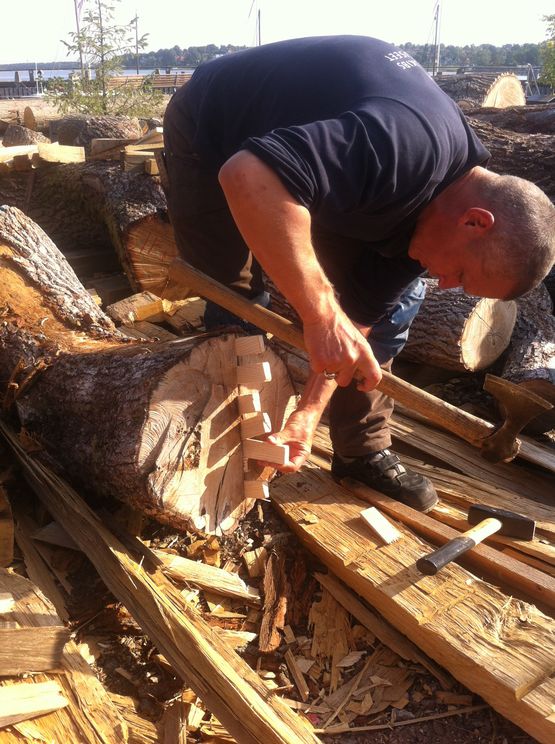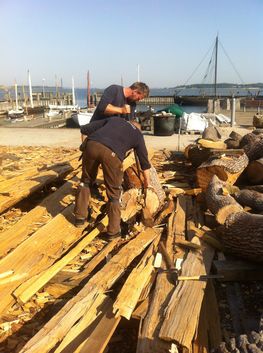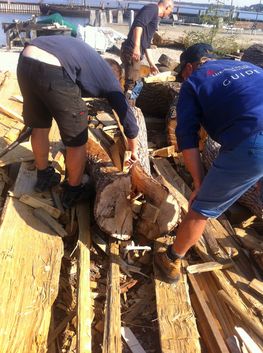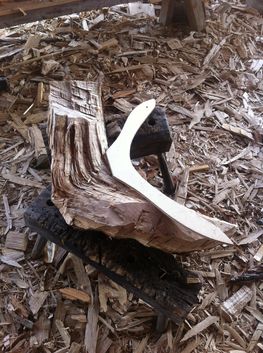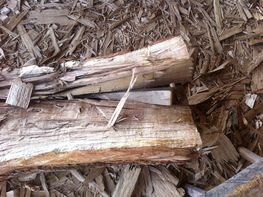Experimental archaeology lies at the heart of all the work that is carried out at the Museum’s boatyard. It involves reconstructing artefacts found during excavation in order to explore either their production or specific use, or the technological processes they were a part of. Reconstructing artefacts allows us to gain new insight into past technologies, and thereby gain a deeper understanding of the practicalities of daily life in the past.
In the context of the experimental archaeological research carried out at the Museum, the technologies in question concern boats and ships: not just boatbuilding, but also all of the ancillary crafts and processes that provided essential elements of the finished vessels. This includes:
- Spinning and weaving wool and other fibres to make sailcloth
- Hand-laying rope
- Making charcoal to fuel the furnaces and forges for the smelting and smithing of rivets
- Producing oil and tar to prolong the life of the wood
It is important to underline that experimental archaeology is not an attempt to understand how people in the past thought or felt: this is information we can never access and modern experimental archaeologists have a duty to avoid making the kinds of interpretations that are based more on our own experiences as 21st century people than on the hard evidence to hand. We will never know why someone 1,000 years ago decided to build a boat, but we can draw some conclusions concerning how that boat was built and the ways in which it was used. When practicing experimental archaeology, it’s essential to let the original artefacts and materials do the talking. Our role as researchers is to be objective, ask the correct questions of the material and to let ourselves be guided by the results that arise.
Cleaving crooked timber – or not…
Within the Gislinge Boat Project, there are several avenues of experimental archaeological research that will be explored both during and after the construction of the boat. One of these areas is the potential advantage of cleaving crooked timber when making the curved floor timbers and frames. Cleaving would allow for a stronger finished element: the cleaving process means the timber splits along the line of the tree’s fibres, and not across them. This causes less breakage of the fibres than you experience with sawing, preserving more of the timber’s integral strength.
Last Thursday, Ture and Niels carried out the first trial with cleaving crooked timber for the Gislinge Boat. When the boatbuilders went into the forest during the winter to select wood for the Gislinge boat, they were armed with a series of moulds, so they could find pieces that had the required shape and dimensions for the floor timbers and other curved elements of the boat. Last week, it was the turn of one of these crooked timbers to be cleaved. After examining the piece, Ture marked up the preferred line of the split and started to work the first small edges into the end of the log. As the split progressed along the length of the log, larger wedges were used and a froe and axe were also used to help split the internal fibres. After roughly half an hour, the log was split and the boatbuilders could stand back and take stock of the process.
Letting the find talk
The cleaving went as planned and the wood cleaved along the line Ture had chosen. The two very crooked halves that now lay on the ground prompted him to go back to the original 1:1 drawings of the original floor timbers. Ture noticed that all of the floor timbers had visible pith. When cleaving radially, the wood splits through the pith (the centre of the wood) and the pith is generally lost when the wood is worked into its finished shape. If the timbers from the Gislinge Boat find had been cleaved, there shouldn’t be any noticeable pith in the surface grain of the wood. The archaeological material suggests therefore that the crooked timbers had been produced from relatively straight-growing branches, which were chopped to size with an axe, and not from larger sections of timber that were cleaved.
This interpretation was further supported by the construction of the boat itself. The biti (crossbeams) in the Gislinge Boat sat atop the frames and acted as the thwarts for the boat’s crew. It was therefore essential that the frames were made from straight-growing, or straight-shaped, timbers. If the floor timbers had been cleaved, the slightly twisted growth of the branches or timbers would most likely have resulted in pieces that were too curved to provide the rather straight floor timbers seen on the Gislinge Boat. This observation will be tested further by the cleaving of more pieces of crooked timber. However, the cleaving of just one piece of crooked timber demonstrates one of experimental archaeology’s strengths: the cleaving of a small piece of crooked timber gives rise to reflection, and this new knowledge gives cause for a new look at the original drawings, leading to a more qualified reconstruction of a boat.
An evolving process
Ture is quick to point out that these are by no means definitive conclusions, after just the one cleaving trial. That was the first crooked timber to be cleaved during the building of the Gislinge Boat, and the boatbuilders and archaeologists must work further with the many considerations and questions that the process has set in motion.
This example with the cleaving of a small piece of crooked timber highlights the strength of experimental archaeology as a research method: the combination of traditional academic analysis with the craftsmens' work, insight and knowledge, results in a new understanding of the archaeological material.
We don’t know for what purpose the Gislinge Boat was built, but working with an experimental archaeological reconstruction of the find, we’re getting closer to an understanding of the work processes the original boatbuilders near the Isefjord went through in the 1100’s, when they went into the forest to select the timber for the boat.
» <link https: www.facebook.com external-link-new-window external link in new>Follow the project on Facebook...
» <link https: instagram.com vikingshipmuseum external-link-new-window external link in new>Follow the project on Instagram...
